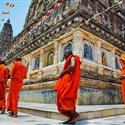 We cannot draw a circle without a center point. The Lord is the center, source and essence of our lives. Recognizing Him as the focal point in our lives, we go about doing our daily chores. This is the significance of pradakshina.
Also every point on the circumference of a circle is equidistant from the center. This means that wherever or whoever we may be, we are equally close to the Lord. His gr... Read more »
We cannot draw a circle without a center point. The Lord is the center, source and essence of our lives. Recognizing Him as the focal point in our lives, we go about doing our daily chores. This is the significance of pradakshina.
Also every point on the circumference of a circle is equidistant from the center. This means that wherever or whoever we may be, we are equally close to the Lord. His gr... Read more »
_thumb_pliSmall.jpg) The tilak or pottu invokes a feeling of sanctity in the wearer and others. It is recognized as a religious mark. Its form and colour vary according to one’s caste, religious sect or the form of the Lord worshipped. In earlier times, the four castes (based on varna or colour) – Brahmana, Kshatriya, Vaishya and Sudra – applied marks differently. The brahmin applied a white chandan mark signifying p... Read more »
The tilak or pottu invokes a feeling of sanctity in the wearer and others. It is recognized as a religious mark. Its form and colour vary according to one’s caste, religious sect or the form of the Lord worshipped. In earlier times, the four castes (based on varna or colour) – Brahmana, Kshatriya, Vaishya and Sudra – applied marks differently. The brahmin applied a white chandan mark signifying p... Read more »
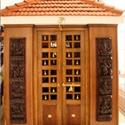 Most Indian homes have a pooja room or altar. A lamp is lit and the Lord worshipped each day. Other spiritual practices like japa (repetition of the Lord’s name), meditation, paaraayana (reading of the scriptures), prayers, and devotional singing etc is also done here. Special worship is done on auspicious occasions like birthdays, anniversaries, festivals and the like. Each member of the family –... Read more »
Most Indian homes have a pooja room or altar. A lamp is lit and the Lord worshipped each day. Other spiritual practices like japa (repetition of the Lord’s name), meditation, paaraayana (reading of the scriptures), prayers, and devotional singing etc is also done here. Special worship is done on auspicious occasions like birthdays, anniversaries, festivals and the like. Each member of the family –... Read more »
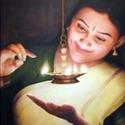 In almost every Indian home a lamp is lit daily before the altar of the Lord. In some houses it is lit at dawn, in some, twice a day – at dawn and dusk – and in a few it is maintained continuously (akhanda deepa). All auspicious functions commence with the lighting of the lamp, which is often maintained right through the occasion. Light symbolizes knowledge, and darkness, ignorance. The Lord is... Read more »
In almost every Indian home a lamp is lit daily before the altar of the Lord. In some houses it is lit at dawn, in some, twice a day – at dawn and dusk – and in a few it is maintained continuously (akhanda deepa). All auspicious functions commence with the lighting of the lamp, which is often maintained right through the occasion. Light symbolizes knowledge, and darkness, ignorance. The Lord is... Read more »
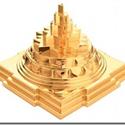 The conclusions of recent researches on Sri Chakram by Alexei Kulaichev, a senior researcher in the Biology faculty of Moscow State University, using modern exact sciences and electronic computers have evoked the interest of historians, ethnographers and scientists throughout the world.
The scientist was inspired to study its structure comprehensive struck by its austere geometric beauty... Read more »
The conclusions of recent researches on Sri Chakram by Alexei Kulaichev, a senior researcher in the Biology faculty of Moscow State University, using modern exact sciences and electronic computers have evoked the interest of historians, ethnographers and scientists throughout the world.
The scientist was inspired to study its structure comprehensive struck by its austere geometric beauty... Read more »
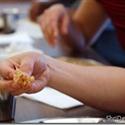 Within the westernized culture, eating food with hands is perceived wrongly as unhygienic, bad mannered and primitive. In India we now have always eaten with your hands and, as proverb says, “Eating food with your hands feeds not simply the body but the mind and spirit".... Read more »
Within the westernized culture, eating food with hands is perceived wrongly as unhygienic, bad mannered and primitive. In India we now have always eaten with your hands and, as proverb says, “Eating food with your hands feeds not simply the body but the mind and spirit".... Read more »
 Peepal tree is of great medicinal value. Its leaves serve as a wonderful laxative not to mention tonic for your body. It is very ideal for patients experiencing Jaundice. It really helps to control the unwanted variety of urine released during jaundice. The leaves of Peepal are noteworthy for heart disorders. It enables the control the palpitation of heart and thereby combat the cardiac weakness. ... Read more »
Peepal tree is of great medicinal value. Its leaves serve as a wonderful laxative not to mention tonic for your body. It is very ideal for patients experiencing Jaundice. It really helps to control the unwanted variety of urine released during jaundice. The leaves of Peepal are noteworthy for heart disorders. It enables the control the palpitation of heart and thereby combat the cardiac weakness. ... Read more »
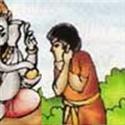 Thoppukaranam is a traditional practice in Indian Schools, accepted from Gurukula system of education right from Sannipani Ashram(Sri Krishna's time) to make the child sit and stand catching both the ears with hands crossing each other symbolising punishment for lethargy, laziness and not memorizing or grasping and to improve brain power etc. Though it has degenerated into a punishment, the reason... Read more »
Thoppukaranam is a traditional practice in Indian Schools, accepted from Gurukula system of education right from Sannipani Ashram(Sri Krishna's time) to make the child sit and stand catching both the ears with hands crossing each other symbolising punishment for lethargy, laziness and not memorizing or grasping and to improve brain power etc. Though it has degenerated into a punishment, the reason... Read more »
 The Gotra is a system which associates a person with his most ancient or root ancestor in an unbroken male lineage. For instance if a person says that he belongs to the Bharadwaja Gotra then it means that he traces back his male ancestry to the ancient Rishi (Saint or Seer) Bharadwaja. So Gotra refers to the Root Person in a person’s male lineage.... Read more »
The Gotra is a system which associates a person with his most ancient or root ancestor in an unbroken male lineage. For instance if a person says that he belongs to the Bharadwaja Gotra then it means that he traces back his male ancestry to the ancient Rishi (Saint or Seer) Bharadwaja. So Gotra refers to the Root Person in a person’s male lineage.... Read more »
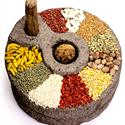 Sokku Vaidhyam Indian Traditional Baby Home Made Medicine... Read more »
Sokku Vaidhyam Indian Traditional Baby Home Made Medicine... Read more »